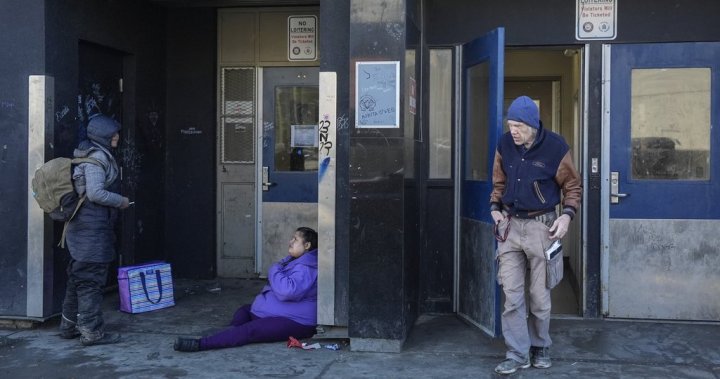The black concrete walls outside Saskatoon's only safe consumption site show the awakening left behind by the city's drug crisis.
The names of most people who died from drug addiction are scribbled in the Prairie Harm Reduction Building. Support Services Director Kim Randall points out the names of the women who went to the Baby Sith. She passed away in January.
“She worked for us for years,” Randall told the Canadian press. “It really was a huge blow to the community.”
Support worker Vernkeeper lost his partner charity five years ago. Her name is also on the wall.
“Overdominates a couple of times a day. I'm grateful that I got on time for so many,” the Keeper said.
Outside of downtown, Prairie Harm Reduction is struggling with the crisis of Saskatchewan's biggest city. A very toxic batch of drugs with pale pink or dark purple tablets in January, some of which permeated Saskatoon.
Kayla Demong, the organization's executive director, said last month that more names were added to the wall.
“I have an envelope in my office full of funeral cards. It used to be hanging. I can't see it anymore,” she said, sweeping her tears away.
The drop-in centre has recently reopened after temporarily closing to give staff a break. That safe consumer room will remain closed until Demon hires a new paramedic. The last paramedic was burnt out and stopped.
The central sign encourages people to carry naloxone, test the drug, and not use it alone. The client comes and grabs coffee and food. They sit on the couch, chat and watch TV.
More Video Details
Some also use substances. The staff will check in to see if they are okay.
Joseph Little Crow said he turned black a month ago while smoking fentanyl outside the building.
The 47-year-old said the firefighters were called to give him three times of naloxone, medication and oxygen to reverse overdose. They also revive the young woman he met that day.
Little Crow woke up to those staring at him. He said he was angry.
“I wasn't afraid of me living or dying. I wanted to die. But I'm really grateful (I'm alive),” he said.
He said he sometimes sleeps on the streets at night.

Get weekly health news
Receive the latest medical news and health information provided every Sunday.
“I was sober, calm, for the second year in a row, but that's been a struggle ever since now,” Little Crow said.
The crisis has reached a widespread effect on first responders who have dealt with the call surge. The people are also seeing that.
Overdose in the facility and violence against staff have closed two of the city's libraries. Dr. Freda Ahenakew and Frances Morrison Central Libraries are expected to reopen for full April 21, with more security and protocols.
“That has become a difficult point for us to manage as a library,” said Carol Shepstone, CEO of Saskatoon Public Library.
Data from Saskatoon's Emergency Operations Center show that firefighters have been receiving 901 drug addiction calls since January, with more than half of them occurring in March. At this point last year, they went to 352.
The Saskatchewan Coroner's Service has reported seven confirmed overdose deaths in the city this year. There have been 16 confirmed deaths across Saskatchewan. Officials say 76 people are suspected to be linked to overdose.
Dwayne Jobson of the Saskatoon Fire Department said he was driving around downtown and Riverdale. He said he has never seen anything like that in his 32-year career.
“What words should I use? It's outrageous. It's overwhelming,” the battalion chief said.
“(Naloxone) wasn't working right away. Some of the drugs on the streets were very strong and almost resistant. We were seeing people paralysis.”

People at the back, near churches, apartments and hospitals, along streets and alleys, meander between the houses. Others are sitting on the sidewalk with their belongings.
Trend now

Election Canada says it doesn't matter whether Canadians use pens or pencils when casting votes

Pope Francis Dead: Catholic Church leader dies at age 88
He waves to the people he drives.
“You can hear terms like, “These people live on the streets.” It's like they're surviving,” Jobson said.
“We all have empathy for these people. We just go and help.”
Pamela Goulden-McLeod, the fire department's emergency management director, said the city is beginning to have fewer overdose calls, but it's above average.
The Emergency Business Center is working with the state government to supply more naloxone and paramedics. We've collected this data, which was activated in March, to see where the overdose is occurring and who is affecting it.
“What we desperately need is demographic data, data that helps identify process gaps, data that not only address this issue, but also helps to facilitate planning how to address this issue,” Goulden-McLeod said.
Mayor Cynthia Block said Saskatoon needs more housing, including units with support services. She said the first phase of the new support housing facility is expected to open this year, while other projects are in the planning phase.
However, she recently closed two winter warming shelters. It can happen every year.
“We don't seem to learn that we do the same thing over and over and over and expect another outcome won't work,” Brock said.
She said cities and states need to resolve the partnership that Saskatchewan stepped into housing.
“It's not a winter issue. It's 24-7, 365 days until you can get back to the full residential spectrum and run,” Brock said.
“I'm very supportive of the state's recovery model, but housing has to be the first step when people are trying to survive on the streets.”
Demon said the Prairie Harm reduction also plays a role in meeting where they are, saving lives and reducing calls that first responders have to go.
“If we invest appropriately in housing, healthcare and education, we wouldn't be in the situation where we are,” she said.
“As a country, we have failed again and again in all these areas.”


